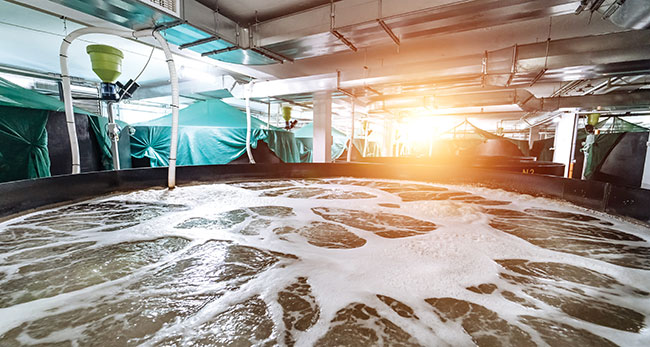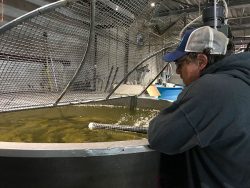
Features
Hatchery Operations
Systems management
The human factor
Keys to daily water quality testing, management
March 15, 2021 By Ron Hill
 Photo: © Vadim/Adobe Stock
Photo: © Vadim/Adobe Stock Monitoring and managing water quality daily is a key process to running any aquaculture facility, especially with recirculating aquaculture systems (RAS). The importance of excellent water quality cannot be overstated, but the gap between knowing its importance and setting up a proper water quality monitoring program is immense. Equally immense is the gap between employees that can take and measure water quality, and those that can interpret water quality and choose when to act. These two keys – a proper monitoring schedule and employees that can use monitoring information to manage water quality – are essential to the health of stock and farm.
Testing
The most important water quality parameters to test are well known; choosing when to test these parameters is as important as choosing which parameters to test for. The basis of a testing system is the testing schedule. The schedule ensures what is most important is properly monitored and creates a valuable database. There are two maxims to help decide when to test: a) the more important a water quality parameter, the more frequently it should be tested for; b) the more a parameter can fluctuate or historically fluctuates, the more it should be tested for.
Oxygen, which is consumed directly by the fish and is essential to life, is the most important parameter and, therefore, monitored in real-time. After oxygen, (which is a topic on its own), un-ionized ammonia is the most important water quality parameter that affects animal health. Un-ionized ammonia is toxic, produced from fish waste, directly related to feed given and, with its toxic partner nitrite, must be monitored daily in a RAS facility.
Fluctuations in pH change the toxicity of other metals and metabolites. Though pH in a system may be historically stable, the detrimental effects of pH changes to toxicity and the ease of testing pH, warrant daily monitoring.
Other water quality parameters and how often they are tested will be specific to the farm, species, system, water source, etc., and should be decided upon based on their importance and fluctuation. CO2, hardness, alkalinity, and known heavy metals may or may not need to be monitored daily but should be scheduled for testing at some interval. Consistent testing to create a good data set, good data keeping, along with historical data complete a water quality testing system, the tool used to manage water quality.
Daily interpretation
Having a proper water quality testing schedule in place is essential. But to manage water quality, humans must be able to interpret the data to make day-to-day decisions. Taking the water quality is generally a simple job and any employee should be able to do it. Running through the tests and analyzing the water is straightforward with clear instructions, and probes are simple to use. Employees who take that next step and can interpret the data to make decisions based on trends is key to an effective water quality testing and management system.
Identifying trends and knowing how to react separates the top employees from their peers. This requires both education and experience with the system and is where a formal education in aquaculture or biology is a major benefit to the employee. To recognize trends in water quality, the employee must first overcome complacency. It’s easy to run the tests, record the data and then move on to other tasks, without taking a few minutes to ask if the numbers make sense and if there are changes or trends. Each day, the water quality tester must look through the numbers from the last few days and ask themselves what parameters are fluctuating and what the detrimental thresholds are. Is the pH of the system slowly rising over the last week? Is the hardness slowly diminishing? Did the un-ionized ammonia spike?

Managing based on water quality
Having identified the trend, the next and most difficult step is to adjust the system to restore desired levels. This step is where experience is the most valuable. The water quality changes for a reason. Knowing the system and the historical solutions to similar problems is invaluable for troubleshooting water quality. Knowing how different systems and tasks affect the water quality give the technician clues where the issue may be coming from. Is the pH dropping each day because the buffering capacity of the water is diminishing? Has the metering pump lost flow and isn’t providing injections, allowing hardness to decrease? Is a biofilter failure allowing un-ionized ammonia to spike? Are the fish being overfed and overwhelmed the biofilter? Are the solid filters working properly? Use the clues and data to find the root cause by exploring the system.
Choosing how to act once the problem has been identified depends on the problem, the farm and the options available to the technician. There are few instant solutions to water quality issues because the system and water are always in motion. Many problems can be corrected right away but the affects of correction won’t be seen until the system runs for a time. Fixing the metering pump will correct the hardness issue but will take some time for the hardness to right itself. For immediate results sodium bicarbonate and/or calcium chloride can be added directly to the system to restore hardness and buffer the pH right away. Again, this is where experience is so valuable- knowing how much to adjust is as important as choosing what to adjust. Over adjustments to water quality are easy to make and can create a situation where staff are chasing the desire parameter range. A tech can find themselves endlessly making adjustments to correct previous adjustments, extending the length of the issue.
Problems with un-ionized ammonia and nitrite must be solved under the stress of choosing to reduce or discontinue feeding, though the addition of chloride ions can lower nitrite toxicity if the chloride concentration is high enough. Un-ionized ammonia is removed by flushing and biofiltration and takes time to diminish. The most important act is to determine where the extra un-ionized ammonia is coming from or why the biofilter is unable to keep pace and correct accordingly. Time will drop the un-ionized if the source of the problem is corrected.
Whatever the issue with water quality, the three most important qualities for technicians – system experience and skill, problem solving and the will to act – are key to managing a water quality testing system and essential to a productive hatchery. Without both experienced staff and a proper testing system, these shortcomings can cause minor issues to become large problems and large issues become catastrophes.
Print this page





